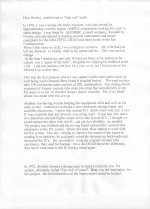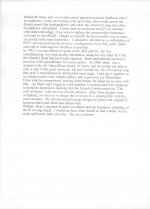I realize that it won't be appreciated by some, but I would like to reinstate the cause that I originally came to input on this thread.
As far as I see it, my best choice is NOT to give you a circuit, or even the tools to fabricate a circuit, yourself, BUT the guidelines to make a SUCCESSFUL AUDIO CIRCUIT
that will rise above and beyond the average mid-fi audio product, so that your efforts will not be in vain, or redundant to what you could more easily get with investing a little more money from the audio marketplace, new or used, and saving your personal energies for something else.
This involves imparting what my colleagues (usually competitors as well) and I have found to make our products more successful than most in the hi end audio marketplace.
First, this is sound quality, of course, but other factors do intrude, at least for us to sell our products to a 'discriminating' market, (and trust me they are VERY 'discriminating'). (more later)
As far as I see it, my best choice is NOT to give you a circuit, or even the tools to fabricate a circuit, yourself, BUT the guidelines to make a SUCCESSFUL AUDIO CIRCUIT
that will rise above and beyond the average mid-fi audio product, so that your efforts will not be in vain, or redundant to what you could more easily get with investing a little more money from the audio marketplace, new or used, and saving your personal energies for something else.
This involves imparting what my colleagues (usually competitors as well) and I have found to make our products more successful than most in the hi end audio marketplace.
First, this is sound quality, of course, but other factors do intrude, at least for us to sell our products to a 'discriminating' market, (and trust me they are VERY 'discriminating'). (more later)
Put some numbers on that, jn would.
Well submarine telephone cables give a worst case 300 volt jumps east/west over a 10,000 or so kilometer so about 30 mv per kilometer, so 30uV per meter at less than about 1 hz or so, I wont be losing sleep over it.
Here's a very interesting article which explains how to avoid the cross-over distortion in capacitors by using a series capacitor in parallel with a battery:
Charge Coupled Crossovers Article By Jeff Poth
John and others, do you think that this cross-over distortion exists and is audible ? Did you ever use a similar circuit in an amplifier you designed ?
Charge Coupled Crossovers Article By Jeff Poth
John and others, do you think that this cross-over distortion exists and is audible ? Did you ever use a similar circuit in an amplifier you designed ?
BUT the guidelines to make a SUCCESSFUL AUDIO CIRCUIT
Good enough to select grains from thorns.
Mr Wayne, be careful not to use nail polish.
He never specified , if he does could i borrow yours ...
Here's a very interesting article which explains how to avoid the cross-over distortion in capacitors by using a series capacitor in parallel with a battery:
Charge Coupled Crossovers Article By Jeff Poth
John and others, do you think that this cross-over distortion exists and is audible ? Did you ever use a similar circuit in an amplifier you designed ?
The pre-tensioning argument (with only 9V) is pretty weak.
The pre-tensioning argument (with only 9V) is pretty weak.
The question (for me) is, does the Dielectric absorption shows itself at all or mostly at the "Zero crossing"?
If yes, then the author explains that the 9V or 18V or whatever low voltage battery, is there to cater for the ‘cross-over capacitor distortion’ at low to moderate signal levels only.
For higher signal levels above the average level he writes “minor distortions at these peaks are masked, not only by the loudness of the sound, but also by other distortions associated with large peaks and displacements”.
George
The question (for me) is, does the Dielectric absorption shows itself at all or mostly at the "Zero crossing"?
That's something that came up here between Earl Geddes and me a couple years ago. When the measurements were made, nope, no sign of "zero crossing." It makes no physical sense for there to be one, but it was easy to check.
The basic rule is that if doing something different alters the sound, then there is "something in it". Getting numbers, or devising a brilliant, watertight technical explanation is worth doing further down the track - if your ambition is purely to enjoy better quality audio, then the easiest path is to carry out simple experiments, in the meantime.Put some numbers on that, jn would.
From my perspective, what's happening is that the spectrum of distortion artifacts is altering, and the 'better' the system already is the easier it is to hear the sound space where those 'noises' are, as something distinct from sound world of the recording. Alter something to a tiny degree, and the distortion 'acoustic' immediately changes, it's audible. The end goal is for the level of those distortion elements to be sufficiently down that any further, trivial changes have negligible audible impact.
Here is an example circuit, exotic enough for you? This is ONLY an example. It will not necessarily work as shown.
Nice John,
That's something that came up here between Earl Geddes and me a couple years ago. When the measurements were made, nope, no sign of "zero crossing." It makes no physical sense for there to be one, but it was easy to check.
The DA stuff there is mostly nonsense. It's funny when claims are made of easily measurable things there are never any measurements. Pease's model is pretty good for many capacitors it is linear and time invariant as opposed the the usual claims of "memory".
Last edited:
- Status
- Not open for further replies.
- Home
- Member Areas
- The Lounge
- John Curl's Blowtorch preamplifier part II

